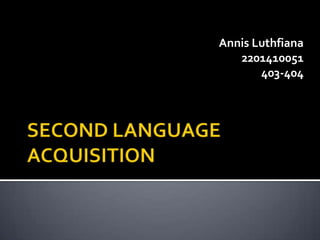
Chapter1
- 1. Annis Luthfiana 2201410051 403-404
- 2. INTRODUCTION: DESCRIBING AND EXPLAINING LANGUAGE ACQUISITION
- 3. It is the systematic study of how people acquire a second language (L2), A recent phenomenon A means of obtaining an education or securing employment ‘Second’ can refer to any language that is learned subsequent to the mother tongue, so it can also refer to the learning of a third or fourth language.
- 4. Differences between: First language acquisition ( Child language acquisition) The field that studies cases of mother tongue acquisition. Second language Acquisition The field that studies language(s) that we learned after acquiring our mother tongue, including third and fourth languages. L2 acquisition is the way in which people learn a language other than their mother tongue, for instance, naturally as a result of living in a country where it is spoken or through instructions in a classroom
- 5. Foreign Language Acquisition The field that studies languages that you acquired inside certain educational environments on purpose. e.g. an English student who learns French as a module in the classroom or a Japanese student who learns English in the UK for taking a TOEFL test. This doesn't mean that they are in the opposite position, but just different terms. In broad sense, foreign language acquisition can be included in the second language acquisition.
- 7. Describing how learner language changes over time by collecting and analysing samples of learners language (spoken or writing). Explain one figures out internal and external factors which play a role for learners who acquire an L2: a) Internal factors like cognitive mechanisms and knowledge b) External factors like the social milieu and the input Findingstrategies that can help us make effective use of our language knowledge.
- 8. It is really important to acquire a second language as the world is becoming more and more globalized, and as a result, demand for studying about By studying SLA, it could be possible to develop new, more proficient teaching methods which can be taught to students who learn a second language. "Much of what we now know about the way people learn languages has been discovered only in the last twenty years, and many teaching methods are much older than that.
- 9. Definition: A case study is a detailed study of a learner s acquisition of an L2. These studies are longitudinal (samples of the learner s speech or writing are collected over a period of time). The Case: The first case study is a study of an adult learner learning English in surroundings of daily communication. The second case study is a study of two children learning English in a classroom.
- 10. SUBJECT Wes, 33 year old artist, native speaker of Japanese Had little formal instruction in English Began to use English as visiting Hawaii for working , finally took up residence Naturalistic learner RESEARCHER Richard Schmidt, University of Hawaii Research for 3 years AIM Observing Wes’ development of knowledge of English Grammar
- 11. METHOD Asked Wes to make recording in English when he went on trips back to Tokyo. Made written transcription of the monologues (1-3 hours) Also made recordings and transcriptions of informal conversations between Wes and his friendsin Honolulu. RESULT Wes still far short of native-speaker accuracy three years later. HOWEVER, it might be wrong to consider Wes as a failed language learner. He did develop in other ways. Achieved considerable success as a communicator
- 12. SUBJECT 1. J: 10 year-old Portugese boy, literate in his native language. - Adventurous, confident 2. R: 11 year-old Pakistani boy, speaking (not writing) Punjabi. - Lack of confidence, RESEARCHE Rod Ellis, writer of this book R & WHERE In a language unit in London & HOW J : Spent 4 school terms (12 months) LONG R :Spent 2 whole school years AIM How the two learners acquired the ability to perform requests for services and good over the period of study.
- 13. METHOD Mixed Instruction Formal and informal language instruction Little exposure to the target language outside the classroom Developmental Verbless Sequences Use imperative verbs Use “Can I have - ?” Extensions of the lingustic devices Finally, “Can” RESULT Both learners were capable of successfully performing simple requests, even when they knew very little English. They manifested development in their ability to perform requests. Many of their requests seemed formulaic in nature. They progressed in much the same was despite the fact that they had different native languages. IMPLICATION They raise a number of important methodological issues relating to how SLA should be studied.
- 14. The second study is more typical of SLA because researchers have to focus on some specific aspects of Language rather than on the whole complex phenomenon. One has to make a distinction between their knowledge and what learners can do. One possibility to measure whether acquistion has taken place or not is to consider the overuse of linguistic forms.
- 15. Learners make errors of different kinds Language learner acquire a large number of formulaic chunks Learners do acquire aspects ofnguage sys a latematically
- 16. involving different kinds of learning Learners must engage in both item learning and system learning Language acquisition needs explanation